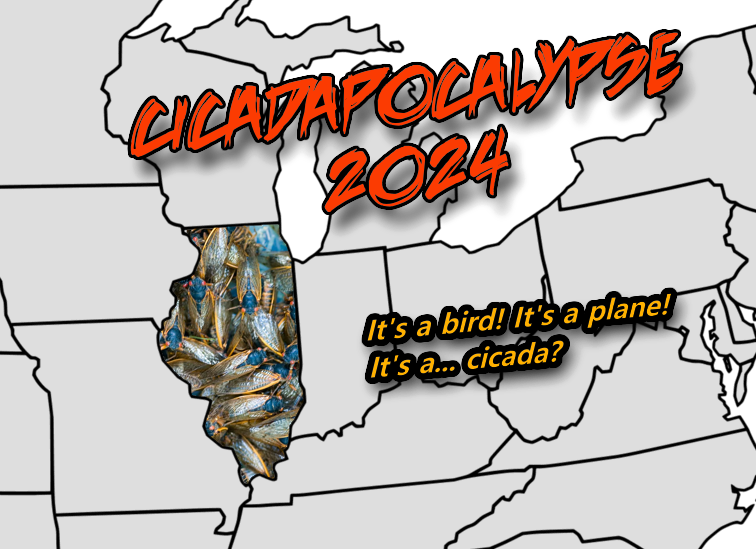What’s the coolest fact about living in Illinois in 2024? That the world’s largest catsup bottle resides here in downtown Collinsville? No, but you’re close – it’s actually that Illinois is one of two states to experience two broods of cicadas emerging in one summer: Brood XIII and XIX. (Okay, well… maybe the catsup bottle is cooler than the cicadas.)
If you have lived here during any part of the summer, there is no doubt you have been lulled to sleep by the song of cicadas harmonizing with chirping crickets. If you live here now, there is also no doubt that you have heard about the oncoming slew of cicadas coming up from below this summer. However, before the “invasion” begins, it’d probably be for the best to learn some basic cicada facts and some info about this summer in particular, just so you are fully prepared when you see your first cicada of the season.
There are three ‘lifespans’ of cicadas in the US depending on the specific brood. They either spend the first 13 years or 17 years of their life underground (which are the two lifespans of periodical cicadas), while some only remain down there for around one year. Once they emerge, they tend to live for four to six more weeks to mate, fertilize and lay eggs – these eggs become the next generation of their respective brood, starting the cycle over. There are approximately 12 broods of 17-year cicadas and 3 broods of 13-year cicadas.
The science surrounding cicadas and their lifestyle isn’t entirely perfect. Some cicada broods are considered “stragglers,” which occurs when they emerge a year or more before their predicted time. These broods are generally not recognized and are the main cause of inaccurate brood distribution maps.
If we hear and see cicadas nearly every year, why is this year so important? This year, the two broods emerging at once will be the 17-year Northern Illinois Brood (XIII) and the 13-year Great Southern Brood (XIX) – both of which are mostly centered in northern Illinois (ie. us). The only other state experiencing both of these broods is Iowa, with brood XIX emerging partially in the southeast region of the state and XIII emerging on the east border. The last time this happened, Thomas Jefferson was president. An important feature of these periodical cicadas specifically is that they emerge synchronously in HUGE numbers, sometimes as much as 1.5 million per acre. This increases the chance of getting their above-ground mission complete: mating.
On the bright side, when two broods emerge together like this it gives scientists a chance to study parasites and diseases that affect these cicadas that they don’t get very often.
Scientists in Kansas hope to study a parasite known as Massospora. The fungus will unfortunately take over the lower half of its body and replace its abdomen and genitals with fungal tissue. It does cause behavior changes, but not in the way you would expect. Scientists have noticed hypersexual behaviors in cicadas with the fungus. The males will pretend to be females so healthy males will come and try to mate with them, thus spreading the parasite. This specific parasite only infects about five percent of the cicada population.
In Illinois, we typically see the small (about one inch in length) green cicadas. However, in this double brood, we are going to see a less common type: slightly larger black cicadas with red eyes.
Even though black cicadas with red eyes may seem terrifying, cicadas are of no harm to humans. The most damage they can do is tickle you with their wings or startle you with their loud chirps.
Cicadas have evolved to mostly drink nectar and nutrients from the roots of trees. Because of this, there’s no need to worry about getting bitten by one: they cannot bite you simply because they never developed any jaws to bite with! They may be ignorant and try to drink some nectar from you, but they don’t mean it.
Their parasites also cannot harm humans and mostly ONLY affect cicadas, not even other similar bugs. If you have a fear of bugs… I don’t think I can convince you to like these guys. They are bugs, after all. That’s for certain.
But trust me – all cicadas want to do is get to a tree and to find a mate. So, if you see a cicada crawling on the ground towards a tree, muster up some courage to help the dude out. He’s been waiting around 13-17 years to get to that tree!














